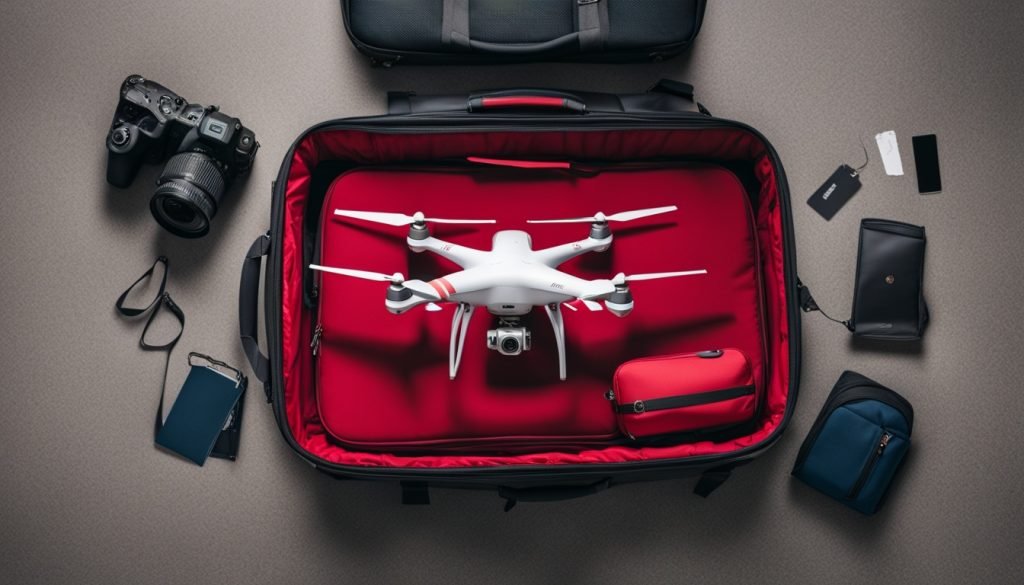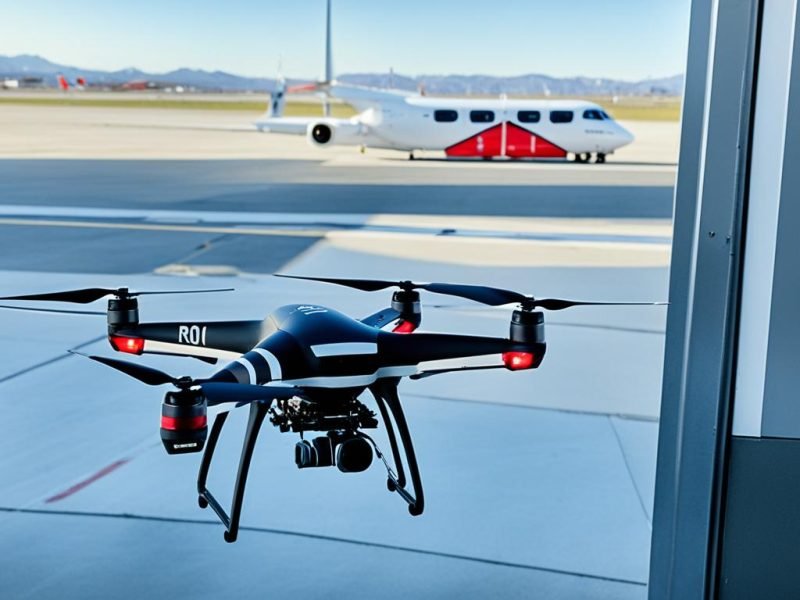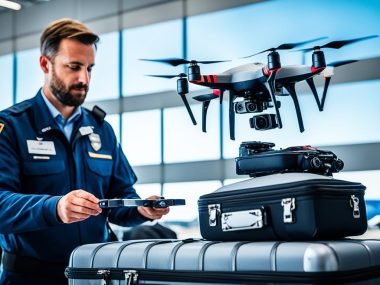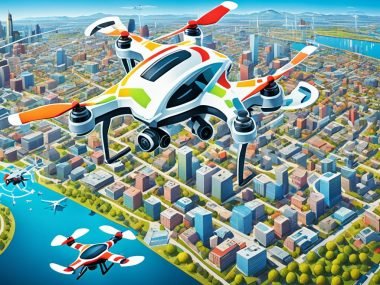I love capturing the world from above with my drone. But did you know that drone registrations have jumped by 60% since last year? This huge increase means more people are asking if they can bring their drones on planes. Luckily, you can usually take your drone through the security checkpoint. But, packing your drone for a flight requires knowing the rules. These regulations differ from one airline to another. So, it’s key to check with your airline about their drone policies before you fly.
It’s crucial to know that most drones need lithium batteries to work. The Federal Aviation Administration (FAA) has special rules for these batteries. Also, things like fuel cells or parachutes for drones have their own rules. While the Transportation Security Administration (TSA) often lets drones through, the choice really depends on the TSA officer. Being aware of TSA and airline drone policies is important. It helps when planning to take your drone on a trip.
Key Takeaways
- Always confirm drone on plane regulations with your airline before traveling.
- Drones with lithium batteries have specific guidelines; familiarize yourself with them.
- The TSA permits drones through security, but the decision ultimately lies with the screening officer.
- Check for updates on FAA regulations that may affect your ability to bring a drone aboard an aircraft.
- Prior knowledge of individual airline policies regarding drones can save you time and trouble at the airport.
Understanding Drone Carry-On Restrictions
If you love drones like I do, you’ll want to know about drone carry-on restrictions for air travel. Getting great aerial shots can get tricky if you’re not up on airline drone policies. I’m here to help by laying out what you need to know about flying with drones on planes.
FAA Guidelines for Drones in Carry-On Bags
The Federal Aviation Administration (FAA) sets the safety rules for flying with drones. Drones can go in carry-on bags, but there are rules to follow. Knowing these rules helps you breeze through security without problems.
Lithium Batteries and Other Components in Drones
Lithium-ion batteries in drones need extra care. You can only pack them in carry-on bags and must watch their wattage. They pack a lot of power but can be risky. Following the rules ensures a smooth trip through the airport.
Checking Drone Policies with Your Airline Before Travel
Airlines each have their own airline drone policies. Always check with your airline before your trip. A quick call or website visit can clear up any confusion. This will make boarding smoother for you.
In sum, drones open up new perspectives for exploration and photography, but they also mean more rules when flying. By keeping informed about drone carry-on restrictions, understanding battery rules, and checking airline policies, I make sure my drone flights go smoothly.
Preparing for Takeoff: Flying with Drones and TSA Regulations
As a drone lover, I make sure I’m ready before going to the airport. Making sure my drone fits the TSA drone policy and airline rules is crucial. It helps my travel go smoothly.
Disconnecting Your Drone Battery for Flight
I always disconnect my drone’s battery before a flight. This stops it from accidentally turning on, which could be unsafe. Doing this makes me feel sure my drone is safe and set for takeoff.
Ensuring Compliance with Airline-Specific Drone Policies
Finding out each airline’s drone policies is key for me. Airlines all have different rules, so I check to avoid problems when bringing drones on flights. I make sure I’m doing everything right to have a hassle-free trip with my drone.
Navigating TSA’s Policy on Drones Through Checkpoints
I also learn about the TSA drone policy in depth. The TSA site for drones is filled with info that guides me at checkpoints. Knowing this, I go through security easily with my drone.
To wrap up, steps like unplugging batteries, knowing airline rules, and getting TSA info make flying with drones great. Keeping up with these points isn’t just advice but a must for any drone flyer aiming for the sky.
Battery Guidelines: Watt Hours and Airline Approval
Traveling often and loving drones taught me a big lesson. Knowing about drone travel rules is as important as checking your flight. When it comes to batteries, understanding lithium batteries regulations is key. This makes sure you face no issues on your trip. Drones use lithium batteries for their powerful energy. But, the Federal Aviation Administration (FAA) sets strict rules for these.
Batteries up to 100 watt-hours are okay in carry-ons with no trouble. Trouble starts with extra drone batteries over this limit. Then, you need to get the airline’s okay. Wondering about spare limits? Best to carry just two to avoid extra attention or security worries.
Here’s the clear info you need:
| Battery Type | Watt-Hours (Wh) | Carry-On Baggage | Checked Baggage | Airline Approval Required |
|---|---|---|---|---|
| Lithium-ion (standard) | Less than 100Wh | Yes | No | No |
| Lithium-ion (spare) | Less than 100Wh | Yes (Up to 2 spares) | No | No |
| Lithium-ion (spare) | 100-160Wh | Yes (Up to 2 spares) | No | Yes |
| Lithium-ion (extended capacity) | More than 160Wh | With Approval | No | Yes |
It’s not just about following rules for the sake of it. It’s about keeping everyone safe, you and your drone included. My tip? Always double-check with your airline. They might have tighter rules than the FAA’s lithium batteries regulations.
Always put safety first. Knowing and following the drone travel rules could mean the difference between an amazing trip and one that’s grounded.
Protecting Your Drone En Route: Packing for Safety
Packing drones for air travel is all about keeping them safe. As someone who loves drones, I know how crucial their journey is. Making sure your drone gets to your destination without damage is key.
Choosing the Right Case for Your Drone
I start by picking a case that best protects my drone. Cases vary greatly, depending on the drone model. A good case has shock-absorbing padding, a tough outside, and special spots for each part.
Everything from propellers to batteries fits perfectly. This makes packing drones for air travel easy.
Preventing Damage During Transit
To avoid damage while moving around, I have a routine. I use cushions for the gimbal, a lens guard, and fireproof bags for the batteries. These steps help avoid problems during transit.
| Case Feature | Benefit | Consideration for Travel |
|---|---|---|
| Hard Shell Exterior | Protects against impacts | Size within airline carry-on limits |
| Custom Foam Inserts | Cushions specific drone models | Modularity for different components |
| Lockable Zippers | Secures the drone against theft | TSA-approved locks for compliance |
| Waterproofing | Shields against moisture | Durability in varied weather conditions |
Understanding how to pack drones for travel is vital for a worry-free trip. A well-protected drone means I can enjoy aerial views right after landing.

International Drone Travel: Customs and Beyond
Traveling with a drone internationally means you need to know the international drone laws and drone customs regulations. There are different rules in each country that can impact your drone use. Knowing these laws is key to enjoying your drone without trouble.
In some places, you must register your drone when you arrive. This can involve showing your drone’s purchase proof, its details, and sometimes why you brought it. It’s also important to know the local drone customs regulations and flying rules.
If you’re from the U.S., you might register your drone as a “Personal Effect Taken Abroad”. This tag helps smooth talk with customs when coming back. But, make sure it’s listed correctly to avoid problems when you return.
Before you go, research the international drone laws of your destinations. Rules can vary, and some places have no-fly zones that are not always obvious. Checking these can save you from fines or losing your drone.
Stay updated on law changes. Sometimes, drone rules change after you’ve planned your trip, leading to unexpected limits on your drone use. Being informed keeps you lawful and protects your drone from legal issues.
Taking a drone abroad is smoother when you understand drone customs regulations and follow international drone laws. It ensures a good trip and lets you peacefully capture the world from above.
Navigating Drone Insurance and Warranties While Abroad
As an avid drone enthusiast, navigating the drone insurance requirements can be tricky. These requirements change from country to country. Besides getting your drone travel-ready, you also need to meet the drone travel insurance laws of your destinations. Understanding these rules can make or break your travel plans with your drone.
Before flying internationally, finding out what insurance you need is key. This step helps you fly the skies without worrying about liability. Doing this research prepares you for a stress-free trip with your drone.
Understanding Insurance Requirements in Different Countries
Traveling with a drone means facing different drone insurance requirements at each stop. The options range from mandatory liability insurance to optional full coverage. One country might strictly enforce these rules, while another might not. Getting the right drone travel insurance saves you from damage costs and legal issues.
Keeping Your Investment Safe with the Right Warranty
Choosing a good drone warranty is essential. A strong warranty protects you from costly defects and issues. I recommend Skydio for their warranties that suit adventurous drone users. This added protection gives you peace of mind during your travels.
| Country | Insurance Requirement | Warranty Providers |
|---|---|---|
| Germany | Mandatory Liability Insurance | Skydio, DJI Care Refresh |
| Japan | No Mandatory Insurance | Yuneec Extended Service |
| Canada | Liability Insurance Recommended | Autel Robotics Warranty |
| Australia | Insurance for Commercial Use | Parrot Care |
With the right info and protection, your drone’s ready for international flights. Enjoy your travels knowing you’re well-protected against any unexpected issues.
The Importance of Test Flights Before Your Journey
As a drone enthusiast, I always look forward to flying my drone. But, careful pre-travel drone checks are crucial for a good flight. These checks include drone test flights. They make sure every part works right. Prepping drones isn’t only about battery charging. It’s also about making sure they fly reliably.
I follow a detailed routine before flying. It covers everything that might go wrong. I’ll share my pre-flight steps:
- Firmware Check – I ensure the drone’s software reflects the latest updates from the manufacturer.
- Propeller Examination – I look at each propeller for damage or wear. I also check if they’re properly attached and working.
- Control Responsiveness – I do a ground test to check if the controls respond well to commands.
- Gyro Calibration – I make sure the drone’s gyroscopes are calibrated for a steady flight.
- Battery Health – I check if the battery holds a good charge and look for any wear that might shorten flight time.
These pre-travel drone checks give me the confidence to get great aerial shots. Even a small step like a drone test flight can prevent big problems.
Are you planning to travel with your drone? Remember: Great aerial photos and smooth video come from the effort you put in beforehand. By preparing drones for flight well, you’ll be set for any challenges in capturing aerial views on your travels.
Ensuring Proper Drone Registration with the FAA
Getting ready to take my drone on various adventures means understanding one key thing. If my drone weighs more than 0.55 pounds, getting an FAA drone registration is a must by law. It’s important to know and follow the drone registration process. This ensures my flights are legal and responsible. This process not only provides accountability but also smoothens travels across borders. That’s where the FAA identification for drones might be checked.
Steps to Register Your Drone
Registering my drone with the FAA is easy and straight to the point. I begin online at the FAA’s DroneZone site, where I enter details about my drone and me. A small fee makes the registration last for three years. By following every step correctly, I ensure my drone use is fully legal under federal laws.
Affixing FAA Registration Number on Your Drone
Once I’ve registered, I need to place the FAA identification for drones number on my drone. It has to be visible from the outside. This helps in identifying it if something goes wrong or it gets lost. I ensure the number is clear and firmly attached to my drone’s body. This is how I follow FAA rules.
Registering my drone with the FAA is about obeying the law and being safe. By sticking to the drone registration process and showing the FAA identification for drones the right way, I’m set to fly high worry-free. It also means respecting the space we share with other flyers.
Conclusion
My study on whether you can bring a drone on a plane brings a clear “yes.” But, you need to know and follow TSA and FAA rules. It’s essential to stay updated on airline policies and international laws for drones. This helps protect your drone and makes airport security smoother.
Preparation is vital. Make sure your drone is insured and packed properly to avoid damage. This way, your drone will be ready to capture amazing views on your trips. Being aware and prepared makes drone use responsible.
Also, being polite with your drone goes a long way. It can lead to new friendships among drone lovers. So remember, before you travel with your UAV, think safe and enjoy flying. And, don’t forget to cherish the views from above.







